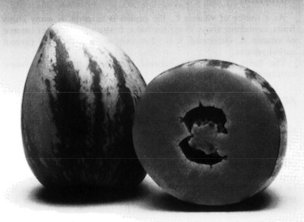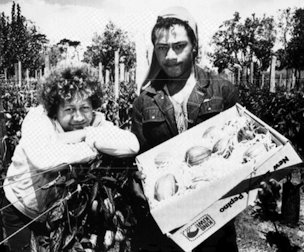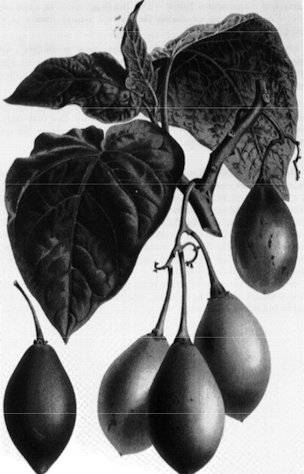Pepino
The pepino dulce 1 (Solanum muricatum)
is a common fruit in the markets of Colombia, Ecuador, Peru, Bolivia,
and Chile. It comes in a variety of shapes, sizes, colors, and
qualities. Many are exotically colored in bright yellow set off with
jagged purple streaks. Most are about as big as goose eggs; some are
bigger. Inside, they are somewhat like honeydew melons: watery and
pleasantly flavored, but normally not overly sweet. 2
Despite
the fact that South Americans enjoy this fruit, there seems to be a
curious lack of awareness for its commercial possibilities elsewhere.
Although pepinos are related to, and grown like, tomatoes, they
nevertheless remain a little-known crop, and their various forms are
currently unexplored and underexploited.
This plant's obscurity may
not last much longer. In Chile, New Zealand, and California, the pepino
(pronounced peh-pee-noh) is beginning to be produced under the most
modern and scientifically controlled conditions. As a result,
international markets are opening up. For example, the fruit has
recently been successfully introduced to up-scale markets in Europe,
Japan, and the United States.
In Japan, consumers have an insatiable
appetite for pepinos, and in recent years they have bought them at
prices among the highest paid for any fruit in the world. Pepinos are
offered as desserts, as gifts, and as showpieces. Often they are
individually wrapped, boxed, and tied with ribbons. Some trendy stores
display pepinos whether they sell or not.
Its success in Japan is
perhaps an indication of its future: the pepino is attractive, it has a
good shelf life, it is tasty, and its shape and compact size are ideal
for marketing.
PROSPECTS
The Andes.
Pepino is an ideal home garden plant; it grows readily from cuttings
and is cheap to produce, and increased demand could greatly benefit
home producers. Given attention by horticulturists, a colorful array of
pepino types—both traditional and newly bred—could bring increased
appeal to consumers from Colombia to Argentina.
The transition to
more extensive production has already begun. In the coastal valleys of
Peru, there are some large fields of pepinos (usually rotated with
potatoes, corn, and other crops). Lima is provided with the fruits
year- round, and a small export trade has begun. In Ecuador, too, a few
fields are grown under advanced agricultural conditions. In Chile, more
than 400 hectares of pepinos are planted in the Longotoma Valley, and
increasing quantities are being exported, notably to Europe. Formation
of cooperatives to develop markets, coordinate transport, and control
quality could lead to greater local and export earnings.
There are
parts of the Andes that are unaware of this crop. In Colombia, for
instance, it is hardly known in most of the highland departments,
although in San Agustín (Valle) and Manizales (Caldas), there are large
farms (fincas) that specialize in pepinos.
Other Developing Areas.
In addition to its wide cultivation in South America, the plant has
been introduced to Central America, Morocco, Spain, Israel, and the
highlands of Kenya. Relatively unknown in other nations but worth
trying in all warm-temperate areas, this seems to be a crop with a big
future fast approaching. Commercial pepino production has been
suggested for southern Brazil, Uruguay, Paraguay, the highlands of
Haiti, Puerto Rico, Guatemala, and Mexico—as well as for the cooler
areas of Africa and Asia (particularly China).
Industrialized Regions.
This crop has potential for production in many parts of Europe, North
Africa, the eastern Mediterranean, North America, Australasia, South
Africa, and Japan, although in some areas it may have to be grown under
glass or plastic to produce the sweet, unblemished fruits demanded by
the top-paying markets.
As noted, pepino is already an established
crop in New Zealand. In the United States, it is grown on a small scale
in Hawaii and California, where several hundred hectares are now under
commercial cultivation. This seems to be the beginning of a promising
new addition to the horticultural resources of much of the temperate
zones.
 The pepino has been called "a decadent fruit for the '90s." It is sweet, succulent, and melts in the mouth.
USES
The
pepino is so versatile that it can be a component of any part of a
meal: refreshment, appetizer, entree, or dessert. South Americans and
Japanese eat it almost exclusively as a fresh dessert. It is highly
suited to culinary experimentation. For instance, New Zealanders have
served it with soups, seafood, sauces, prosciutto, meats, fish, fruit
salads, and desserts. The fruits can also be frozen, jellied, dried,
canned, or bottled.
Pepinos are often peeled because the skin of
some varieties has a disagreeable flavor. It pulls off easily, however.
The number of seeds depends on the cultivar, but even when present, the
seeds are soft, tiny, and edible, and because they occur in a cluster
at the center of the fruit they are easily removed.
NUTRITION
As
a source of vitamin C, the pepino is as good as many citrus fruits,
containing about 35 mg per 100 g. It also supplies a fair amount of
vitamin A. Otherwise, it is 92 percent water and only 7 percent
carbohydrates.
The fruits are normally subacid. Levels of 10–12 Brix (sugar concentration) are common. 3
AGRONOMY
All
pepino cultivars are propagated vegetatively. Cuttings establish roots
so easily that mist sprays or growth hormones are usually unnecessary.
Tissue culture is also possible. 4
By and large, pepino
is grown like its relatives, tomato and eggplant. With its natural
upright habit of growth and fruiting, it may be cultivated as a free-
standing bush or as a pruned crop on trellises. (Supports can be used
to keep the weight of the fruit from pulling the plant to the ground.)
The plant grows quickly and can flower and set fruit 4–6 months after
planting. It is a perennial but is usually cultivated as an annual.
Undemanding
in its basic requirements, the plant has wide adaptability to altitude,
latitude, and soils. When young, it is intolerant of weeds, but it
later smothers any low-growing competition. Established bushes show
some tolerance to drought stress, quickly recovering vegetative growth,
although their yield may be depressed. In dry regions, irrigation is
normally used.
The plants are parthenocarpic, which means they need
no pollination to set fruit. However, self-pollination or
cross-pollination greatly encourages fruiting.
HARVESTING AND HANDLING
Pepinos
are harvested when fruits have a pale yellow or cream background color
(at least in the popular cultivars El Camino and Suma). Fruits left on
the plant until overripe often have poor flavor. Harvesting must be
done carefully because the fruits bruise easily and finger markings
show up. With current varieties, the fruits on a single bush mature at
different times, and several pickings are necessary throughout the warm
season. Yields of 40–60 tons per hectare are not uncommon, and even
more may be possible under greenhouse conditions.
Auckland,
New Zealand. Over the last 20 years, New Zealand horticulturists have
taken up the pepino as a commercial crop and have developed it,
probably to a greater extent than in any other country. Their varieties
derive from clonal material, introduced from Chile (following heat
treatment to remove viruses).
Today, pepinos are being grown on many
hectares, much of it under glass, and the fruits are shipped to North
America, Japan, and Europe. In fact, since 1984, pepinos have been one
of New Zealand's most lucrative fruit exports. (New Zealand Herald)
The
fruits are susceptible to chilling injury and are stored at 10–12°C. At
this temperature they may keep in good condition for 4–6 weeks. (Sea
freighting may be possible from many countries.) A fruit taken out of
storage has a shelf life of several weeks at room temperature.
LIMITATIONS
The
pepino is a little-studied crop, with sparse factual data or commercial
field experience behind it. Particular areas of uncertainty include the
following.
Fruit Quality Few
sweet varieties also have good horticultural and marketing qualities;
the skin, although edible, is often tough and bitter; and improperly
ripened fruit have a bad aftertaste.
Lack of Adaptability The
best fruit candidates are insufficiently hardy for cultivation in many
cool areas and are susceptible to nematodes. High temperatures retard
their growth and reduce the quality of their fruits, and drought
readily kills the bushes because of their shallow roots.
Horticulture
Cultural conditions and plant nutrition can greatly affect fruit color,
sweetness, taste, and overall quality in ways that are not yet fully
understood.
Fruit Set Poor
fruit set is often a problem. The causes seem to include
over-fertilizing, which fosters vegetative growth rather than
flowering, and high temperatures, which cause the flowers to abort. 5
Pests and Diseases
The plant's susceptibility to pests and diseases in regions of
intensive agriculture is scarcely known. Although attacks have rarely
been of economic importance, more intensive cultivation of larger areas
may intensify disease and pest problems. Aphids, spider mites, and
whitefly already have been serious problems in California and New
Zealand. Nematodes and root rot have also been concerns. In addition,
the plants have shown susceptibility to viruses.
RESEARCH NEEDS
Fruit Quality Research
is needed to better understand the causes of the insipid flavor of many
pepinos. If the flavor can be sharpened and strengthened, the crop's
future will be more secure. Approaches might include analysis of the
effects on flavor of different varieties, stages of picking,
postharvest handling, fertilization, and perhaps the use of salt. 6
Cultivation
Cropping systems have not been investigated in depth, and most
commercial growers rely on tomato technology. Future agronomic research
should include analysis of different cultivation practices, stress
tolerance, plant nutrition and irrigation, light and temperature
requirements, pollination, and methods for training and supporting the
plants (such as trellising).
Plant Physiology
The physiological problems relating to fruit set need to be better
understood. Also, a convenient method for judging ripeness, other than
using fruit color, would be extremely valuable.
Genetic Development
Because pepino reproduces easily by seed, it can be improved readily
through selection of sexual variants from cross-pollination. The mixed
genetic composition (heterozygosity) allows considerable range in
character selection. Added to this, vegetative propagation is simple,
which means that any mutant type can be perpetuated without difficulty
and clonal lines established. 7
Market Development
The creation of a new crop requires the development of marketing as
well as horticulture. Because pepinos are new to consumers outside the
Andes, markets are unstable. Furthermore, there is a lack of basic
marketing knowledge, consumer acceptability is unknown, and ultimate
market demand is uncertain. Promotion and market development could do
much to assure the steady advancement this crop deserves.
SPECIES INFORMATION
Botanical Name Solanum muricatum Aiton
Family Solanaceae (nightshade family)
Botanical Synonyms Solanum variegatum Ruíz and Pavón; Solanum guatemalense Hort., and others
Common Names
Quechua: cachun, xachun
Aymara: 'kachan, kachuma
Spanish:
pepino, pepino dulce, pepino blanco, pepino morado, pepino redondo,
pepino de fruta, pepino de agua, mataserrano, peramelon (Canary Islands)
English:
pepino, Peruvian pepino, pear melon, melon pear, melon shrub, tree
melon, sweet cucumber, mellowfruit, “kachano” (an Aymara derivative
that has been suggested to avoid confusion with melons or cucumbers)
Origin.
The place and time of the pepino's domestication are unknown, but the
plant is native to the temperate Andean highlands. It is known only in
cultivation or as an escaped plant. It is an ancient crop, and is
frequently represented on pre-Columbian Peruvian pottery.
Description.
This highly variable species is a sprawling, perennial herb that
reaches about 1 m in height, with a woody base and fibrous roots.
Several stems may arise from the base, and they may establish roots
where they contact soil. The leaves may be simple or compound; when
compound, the number of leaflets may vary from 3 to 7. The white to
pale-purple to bright-blue flowers occur in clusters. As noted, fruits
can be produced without pollination (such parthenocarpic fruits are
seedless), but fruit set is much greater when self- or
cross-pollination occurs. Pollen is not usually abundant. As the stigma
is longer than the anthers, pollination is unlikely to occur unless
pollen is transferred by an insect or human hand.
The fruit varies
from globose to pointed oval. When ripe, the skin background color may
be creamy to yellow-orange. Purple, gray, or green striping or blush
colorations give the fruit distinctive appearance. The flesh may be
greenish, yellow, salmon, or nearly clear.
Horticultural Varieties.
Pepinos appear in markets throughout the Andes, but although there are
many distinct strains, few have been stabilized into named cultivars.
In
Chile, however, there are named varieties. All produce similar purple-
striped, egg-shaped fruits. These are only slightly sweet, with a Brix
rating generally less than 8. The purple stripes mask the bruise marks
so common on the golden, unstriped pepinos. Chile is a major exporter,
and its varieties are now also grown in California and New Zealand.
In
New Zealand, the most common cultivated varieties are El Camino and
Suma. El Camino has medium to large egg-shaped fruit with regular
purple stripes. For reasons that possibly have to do with mineral
nutrients given to the plant, it sometimes produces off-flavored fruits
(these are identifiable by their brownish green color). Suma is a
vigorous cultivar producing heavy crops of medium to large globose
fruits, with regular purple stripes and attractive appearance. Their
flavor is mild and sweet.
In California, New Yorker is the most
widely grown cultivar. Since 1984, however, Miski Prolific has become
equally popular. Its flesh is deep-salmon color, and its skin creamy
white with light-purple stripes. There are a few seeds in each fruit.
Environmental Requirements.
Although
this plant is native to equatorial latitudes, it is typically grown on
sites that are cool. Thus, it is found in upland valleys, in coastal
areas cooled by fog, and parts of Chile where the summers are not hot.
Daylength. Since the pepino fruits well at many latitudes, it appears to be photoperiod-insensitive.
Rainfall.
1,000 mm minimum, well distributed over several months. As noted, the
pepino has little drought resistance, and in Chile and Peru irrigation
is often used.
Altitude. The plant seems unaffected by altitude. It grows from sea level in Chile, New Zealand, and California to 3,300 m in Colombia.
Low Temperature.
Once established, the plant experiences frost damage at temperatures
below 3°C. Seedlings are even more sensitive. Cool, wet weather during
the harvest season results in skin cracking.
High Temperature.
The plant performs best at 18–20°C. With adequate moisture, it can
tolerate intermittent temperatures above 30°C. However, fruit
production then declines, particularly if both day and night
temperatures are high.
Soil Type.
The plant thrives in moderately moist soils with good drainage. Soils
should be above pH 6.0 to avoid disorders such as manganese toxicity
and iron deficiency. If soil is too fertile, there can be problems of
fruit set and fruit quality.
Related Species. Solanum caripense
(tzimbalo) is a possible wild ancestor, which crosses readily with
pepino and bears edible fruit. It is a sprawling plant, more open and
smaller than the pepino, that is fairly widespread in the Andes between
800 and 3,800 m elevation. Its fruits are elongate and slightly smaller
than ping-pong balls. There is, however, little flesh to eat, for they
are mostly juice and seeds. Some are rather intensely flavored, sweet,
and occasionally leave a bitter aftertaste. The plant's advantages are
early fruiting, abundant yields, and fairly tough-skinned fruit.
Solanum tabanoense
is a rare plant found between 2,800 and 3,500 m in southern Colombia,
Ecuador, and Peru. The fruit has an appreciable amount of flesh and is
similar to the pepino in size and taste.
1
In Spanish, “pepino dulce” means “sweet cucumber.” Regrettably, the
shortened name “pepino” is becoming the common name for this fruit in
English, for in Spanish “pepino” refers only to the cucumber. This
fruit, however, is botanically related to tomatoes and is nothing like
a cucumber.
2 Cieza de León, the Spanish chronicler of
the Incas, related that "in truth, a man needs to eat many before he
loses his taste for them."
3 Any dessert-quality fruit should be sweet, with Brix levels above 8—preferably 12 or even more. Information from S. Dawes.
4
Pepinos are easily propagated by seed, but usually the seedlings are
inferior to their parents. Seedlings, however, normally differ widely
from each other, which allows breeders to search for superior new
strains.
5 Hermann, 1988.
6 Tomatoes grown with saline irrigation have become a premium export of Israel because of their tangy taste.
7 Recent studies show that even immature seed is viable if germinated in nutrient agar. Information from J.R. Martineau.
|



